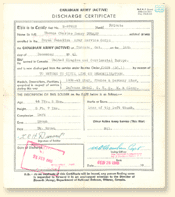

Canadian Army (Active) Discharge Certificate |
Post-War Planning
On December 9, 1939, after only three months at war, the federal
Cabinet established a Committee on and
Re-Establishment, led by the Minister of Pensions and National
Health, Ian Mackenzie. Mackenzie convinced the government to begin
an unemployment insurance programme in August 1940, a major step
towards a full-scale post-war national social security umbrella for
Canadians. In February 1941, Mackenzie persuaded Prime Minister King to form a
Committee of Reconstruction, a study group under Principal F. Cyril
James of McGill University. The Committee published the Report on
Social Security for Canada, which urged a social safety net for the
unemployed, the old and the ill. Although some Liberal Cabinet
ministers and senior public servants strongly opposed big government
of this kind, King could see that both the Progressive Conservatives
and the Co-operative Commonwealth Federation supported the idea, and
that the CCF used it to good effect in federal by-elections. The
Prime Minister built a reconstruction programme that included
important social welfare provisions : health insurance, old-age benefits
and family allowances ( see The Family
Allowances ). There were also measures to ease the transition of
returned servicemen to civilian life ( see Veterans and Veterans'
Programmes ). The government established the Department of Reconstruction in June
1944 to guarantee industrial output and maximize employment during
the move from war to peace. C.D. Howe headed the Department, while
retaining his powerful position as Minister of Munitions and Supply.
On December 31, 1945 the two departments merged to become the
Department of Reconstruction and Supply. Related Newspaper Articles
English Articles
- Post-War Days Must Bring Full Employment for All
The Hamilton Spectator, 19/08/1942
- Still a Blueprint
The Hamilton Review, 19/03/1943
- Cabinet Ministers Differ on Need for Big Works Program
The Toronto Telegram, 17/12/1943
- The Government White Paper
The Toronto Daily Star, 13/04/1945
- Industry is Prepared for Post-War Expansion
The Financial Post, 22/06/1945
- Our Factories Grow
The Hamilton Spectator, 22/11/1945
- The money made in Canada
The Financial Post, 30/11/1945
- Many New Jobs in Portfolio of C.D. Howe
The Financial Post, 04/01/1945
- Minister of Reconstruction Confident Regarding Future
The Hamilton Spectator, 11/02/1946
- Howe's Big Department Preparing for Fadeout Around Mid-Summer
The Globe and Mail, 05/04/1947
French Articles
-
"Bloc-Notes -Guerre, après guerre et chômage"
Le Devoir, 10/01/1940
-
L'après-guerre
Le Devoir, 18/08/1941
-
M. Godbout parle de l'après-guerre
Le Devoir, 30/10/1941
-
Préparer sans retard l'après-guerre
Le Devoir, 21/01/1943
-
Plan d'après-guerre de l'industrie lourde au Canada
Le Devoir, 02/03/1943
-
La province de Québec sera-t-elle prête à prendre sa part?
Le Devoir, 25/03/1943
-
Les Alliés s'entendent à peu près entièrement pour l'après-guerre
Le Devoir, 31/03/1943
-
Que fera-t-on de l'Allemagne
Le Devoir, 23/10/1943
-
M. Howe confiant de la prospérité d'après-guerre
Le Devoir, 29/11/1943
-
La politique d'Ottawa pour l'aviation
Le Devoir, 04/07/1944
-
Lettre d'Ottawa. Vaste projet d'habitations pour l'après guerre
Le Devoir, 07/08/1944
-
"Préparons l'après-guerre au moyen de l'agriculture, dit M. Duplessis"
Le Devoir, 07/09/1944
-
Perspective d'emploi pour l'après-guerre
Le Devoir, 13/09/1944
-
Plans d'après-guerre pour l'agriculture
Le Devoir, 16/09/1944
-
Bloc-notes. Conscription de temps de paix
Le Devoir, 26/10/1944
-
L'avenir de l'Europe
Le Devoir, 11/11/1944
-
La colonisation d'après-guerre
Le Devoir, 17/11/1944
-
Étude des perspectives de l'après-guerre
Le Devoir, 05/12/1944
-
Danger d'inflation d'après-guerre
Le Devoir, 07/12/1944
-
La politique du gouvernement pour l'après-guerre
Le Devoir, 26/06/1945
|